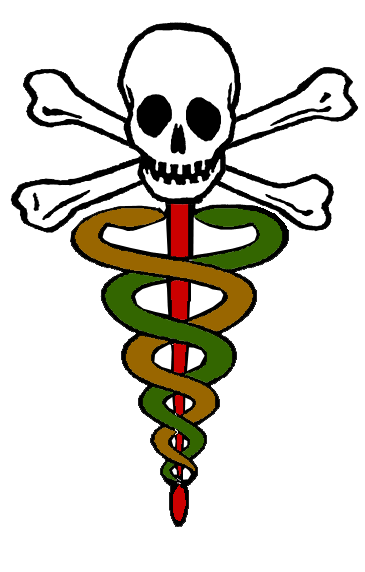
"Some one to kill a man Secundum Artem"
("Someone to kill a man, according to science" — General Arnold's description of a surgeon. )
Warning:
The content on this page discusses medical procedures in the 18th century. As such some of the content is graphic in nature. While every effort has been made so the subject is suitable for all ages, younger or more sensitive readers may find some of the information disturbing.

The scope of this page is three fold. It will:
- briefly look at the background of medicine during the 18th century;
- describe in more detail, some of the common problems facing men at sea;
- discuss some of the specific medical problems faced by pirates due to their life style and choice of careers.
While doing research on this topic I was amazed at the number of misconceptions about 18th century medicine. I think many of these misconceptions are related to the horror stories associated with the misguided practice of "bleeding" and from there it seems a picture of complete and utter incompetence is drawn concerning health care during the Golden Age of Piracy. In reality, the state of medicine and surgery was advancing dramatically throughout the 18th century. Perhaps a little less emphasis should be placed on the claims that George Washington died because he was essentially "bled to death" and some of the misguided medical treatments of Benjamin Rush. Perhaps the teachings of Thomas Moffet and Cosimo Bonomo or the theories of Henri Dran and Lorenz Heister need to be discussed in more detail. It seems it is always more enjoyable, in some morbid sense, to discuss that fallacies of medicine in the 18th century rather than embrace the strides being made to correct pestilence and pain of the time. Unfortunately this paints an incorrect picture of the state of health care during the Golden Age. This essay is will try to present a more accurate look at state of health care during the time in question.
What is considered routine medical practices and common sense today was hardly considered important during the late 17th and early 18th century. Today, many historians, medical professionals and sociologists look back at this time period and shake their heads in disbelief at the horrific treatment methods for the simplest of medical problems. This is a somewhat unfair look at the state of medicine at the time. For lack of better words, the critics of 18th century medicine are "Monday Morning Quarterbacks" it is always easy to look back at poor judgment and point out the fallacies of the situation but it is not as easy to do so before the answer presents itself.
With this said the most often valid complaint given to participants of medicine in the 18th century was that the continued to perform procedures that proved time and again to not only not work but actually cause harm and/or hasten death. The usual example is the bleeding of patients, a procedure that today is known to rarely produce any medical benefit. While the complaint is valid, it is more important to ask 'why?' Why did physicians continue to perform procedures that did not produce positive results?
The two most common answers to this question.
- The Father of Medicine, Hippocrates said so!
- No one had a better answer and there was a lack of effective communication within the world of medicine.
Let's look at these two answers
Hippocrates said so, and then Galen re-enforced the bad medicine.
While many people fault the strong grip of religion on society as a root cause for a stagnant growth in medicine, this is only partly to blame. By the 17th and 18th century, Europe had entered the Enlightenment. It is true that many Christian religious leaders considered most forms of diseases and pestilence as the wrath of God, but the learned men who disregarded the views of Religious leaders embraced a philosophy of science older than Christianity. Many of the Enlightened turned their studies Classic Greek. As such much of the Enlightened Physicians of the day turned to Hippocrates and Galen in the development of healthcare.
Hippocrates felt that all the ills of mankind were due to an imbalance in the body. While he talked of Bloodletting, he preferred dietary changes. Galen went a step further and explained the imbalances occurred in what was known as the Four Humors.
What are the Four Humors, you ask? That would be blood, black bile, yellow bile, phlegm. It was taught by Galen and later accepted among the leading medical experts of the early 18th century that if the humors permeated the body and if they were out of balance then a person would become ill, insane, or in some way incapacitated The Four Humors were related directly with the four elements. (Earth, air, fire, water).
Blood was seen as related to the liver; black bile to the gallbladder; yellow bile to the spleen; and phlegm to the brain and lungs.
The way to treat a person who was ill for whatever reason was to some how bring the four humors back into balance. Blood was believed by Galen to be the biggest cause of imbalance. Unfortunately for most people, it seemed this meant the letting of blood in order to reduce fever, control delirium, eliminate infection, etc, to get things back in order. The Four Humors and Hippocratic medicine were so strongly grounded in the mind set of medicine up and through the 18th Century that if a physician disregarded his teachings the physician ran the risk of being branded a quack. Other wonderful methods of getting the humors balanced including, induced vomiting, urination and diarrhea; in short purging the body of just about any kind of fluid possible.
So you think you have a better idea?
The procedures that most doctors relied on had been established for a long time. New methods were slow to be accepted for a number of reasons; the most common reason was the lack of proof and the lack of effective communications. Today, there are tens of thousands of medical journals that are indexed and abstracted by the National Library of Medicine and are available for anyone in the world to use - visit the pubmed.gov. The first scholarly journals (the way most medical breakthroughs are reported) were not published until 1665. A method of reviewing the accuracy of the information in these journals did not exist for yet another 10 years. And the first example of a controlled experiment did not happen until 1753 when James Lind did his pioneering work on scurvy. To compound the communication problems, medical information tended to be published and even relayed word of mouth in seminars, not in the common language but in Latin.
What this means is that doctors did not have a good way to share information other than word of mouth and presentations at hospitals and the occasional seminar. A prime example of how this lack of communication existed can be summed up by the treatment of smallpox. Muslim countries had been inoculating their children against the dreaded disease for centuries but the procedure failed to reach European nations until 1716, when Lady Mary Wortley Montagu traveled with her husband to the city of Adrianople in the Near East. There, she saw children being engrafted (inoculated) with live smallpox virus. The children would then become slightly ill for three or four days and then return to perfect health. It would be several more years before this unsafe method of inoculations began in Europe. The procedure would reach the Americas around 1751. A more effective method of preventing the disease would not come around for almost another fifty years; despite the fact that many people in Scotland had known for decades that milk maids who caught cow pox (a non life threatening disease) never caught smallpox! It wasn't until 1798 that Edward Jenner finally publishes his work discussing an effective inoculation (vaccination)against smallpox using the cowpox virus.
If diseases were not bad enough, the state of surgery was in an even more dismal state compared to today. Anatomy, the study of the human body was finally being taken seriously which led to some innovations in surgical procedures. At the same time, however, the ideas of sanitation and pain killers was in its infancy. Other medical breakthroughs such as X-rays to find damaged organs, foreign objects, and broken bones were completely unknown.
Yet, despite the dismal state of medicine in the 18th Century, as seen through the eyes of today, the learned men of the 18th century looked upon the medical practice of the day as state of the art and leap and bounds ahead of the health care of previous generations. Doctors in the 18th century understood that diseases were a natural phenomenon and not a wrath from God or an act of witch craft. While they remained ignorant of bacteria and virii, they no longer feared demons. They were able to determine that certain behaviors caused certain conditions or diseases and tried methods to counter those behaviors.
In many ways the path from the Dark Ages of Medicine had been opened. Unfortunately the path to a better understanding of medicine was a bumpy one that led to some poorly conceived notions of medical treatments that lingered far longer than would have been the case, if better communication and a more open minded approach to treatment would have prevailed.
It would be tedious and disagreeable to describe the fate of every miserable object that suffered by the inhumanity and ignorance of the captain and surgeon, who so wantonly sacrificed the lives of their fellow-creatures. Many were brought up in the height of fevers, and rendered delirious by the injuries they received in the way. Some gave up the ghost in the presence of their inspectors; and others, who were ordered to their duties, languished a few days at work among their fellows, and then departed without any ceremony.
From the Adventures of Roderick Random, by Tobias Smollett.

The only author and editor of all pages on the site. Most of what I write about is based on years of book reading on the topic. My first web page was published back in 1994.